Topic: Front
Front
The map below shows a cold, arctic air mass that moved southeast from Canada to cover most of the eastern half of the United States during January 2010.

Which shift caused this flow of cold air out of Canada?
(1) the northward shift of the global temperature zones
(2) the northward shift of the Sun’s vertical rays
(3) a southward shift of the polar front jet stream
(4) a southward shift of the subtropical jet stream
A cross section of a weather front is shown below.
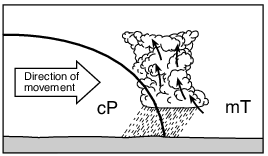
Which symbol would be used to represent this front on a weather map?

(1) 1
(2) 2
(3) 3
(4) 4
The map below shows two seasonal positions of the polar front jet stream over North America.
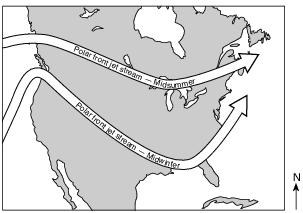
Which statement best explains why the position of the polar front jet stream varies with the seasons?
(1) Rising air compresses and cools in winter.
(2) Water heats and cools more rapidly than land in winter.
(3) Prevailing winds reverse direction in summer.
(4) The vertical rays of the Sun shift north of the equator in summer.
The winds shift from southwest to northwest as heavy rains and hail begin to fall in Albany, New York. These changes are most likely caused by the arrival of
(1) an mT air mass
(2) a cT air mass
(3) a cold front
(4) a warm front

Which type of front was located just south of New York City on December 9?
(1) cold
(2) warm
(3) stationary
(4) occluded
Which cross section correctly represents a cold front and the air-mass movements associated with this front?
(1) 
(2) 
(3) 
(4) 
The diagram below shows the locations of the two major jet streams in Earth’s atmosphere.

Compared to the subtropical jet stream, the polar front jet stream is at a
(1) lower latitude and lower altitude
(2) lower latitude and higher altitude
(3) higher latitude and lower altitude
(4) higher latitude and higher altitude
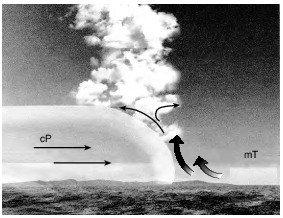
Which type of front is represented by this cross section?
(1) warm
(2) cold
(3) stationary
(4) occluded
The map below shows a typical position and average velocity of the polar front jet stream during two different seasons.

For the eastern United States, the change of the polar front jet stream from this summer position to this winter position causes
(1) warmer temperatures farther north and causes storms to move more slowly
(2) warmer temperatures farther north and causes storms to move more rapidly
(3) cooler temperatures farther south and causes storms to move more slowly
(4) cooler temperatures farther south and causes storms to move more rapidly

Which map best represents the type of fronts and direction of movement of these fronts in relation to the low-pressure center?
(1) 
(2) 
(3) 
(4) 
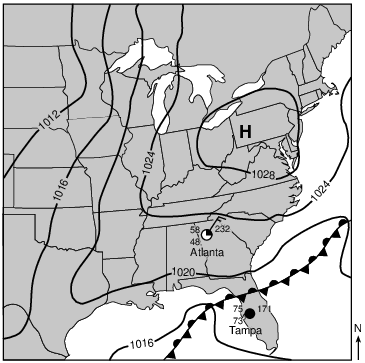
Identify the type of front shown on the map. [1]
front
Allow 1 credit for stationary front.

The cross section in the image provided represents the atmosphere along the dashed line from A to B on the map. The warm frontal boundary is already shown on the cross section. Draw a curved line to represent the shape and location of the cold frontal boundary. [1]

Allow 1 credit for a line that starts from line AB, passes between the cold and warm labels, and curves up to the left.
• Example of a 1-credit response:
• 

Describe the change in air pressure that will most likely occur at Rochester by the time that the cold front has reached Syracuse. Then describe what will most likely happen to the amount of cloud cover in Rochester with this change in air pressure and location of the cold front. [1]
Change in air pressure: Amount of cloud cover:
Allow 1 credit if both responses are correct. Acceptable responses include, but are not limited to:
• Change in air pressure:
• — slight decrease, then a steady increase
• — generally increasing/rising
• — lower to higher
• — greater
• Amount of cloud cover:
• — It decreased.
• — lower percent
• — clear/0%
• — There are fewer clouds.
• — little cloud cover
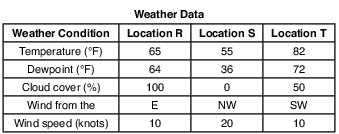
On the weather map in the image provided, draw weather-front symbols on the correct sides of both line XY and line XZ to show the most probable type and direction of each moving front. [1]

Allow 1 credit for the placement of the correct symbols facing in the correct directions for both fronts.
• 
A frontal boundary exists between locations B and C. Identify one process that causes clouds to form in the moist air rising along this frontal boundary. [1]
Allow 1 credit. Acceptable responses include, but are not limited to:
• — expansion
• — cooling to the dewpoint
• — condensation
• — cooling
• — deposition
